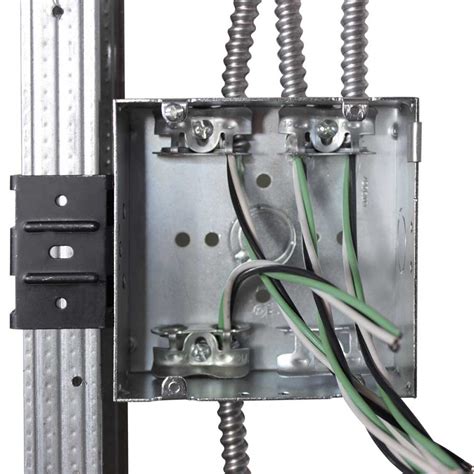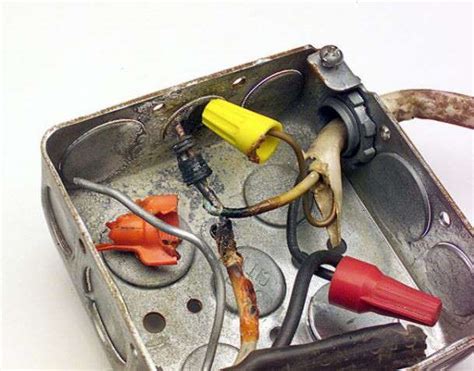aluminum wire in metal boxes #1 - Omit the electrical ground: Connect the ground lines of hot in, hot out and switched-hot wires in an AlumiConn™ connector and leave the metal box ungrounded (not desirable). [And . The following sheet metal gauge size reference chart gives the weight and thickness of sheet metal given as a "gauge" (sometimes spelled gage) and indicates the standard thickness of sheet metal and wire.For most materials, as the gauge number .
0 · mc cable for metal box
1 · aluminum wiring box repair
2 · aluminum junction box repair
3 · aluminum ground wire screws
4 · aluminum ground wire replacement
5 · aluminum ground wire diagram
6 · aluminum electrical box wiring
7 · aluminum electrical box repair
Learn about a junction box as it pertains to a residential home and its electrical wiring, plus DIY tips to install an electrical junction box.
mc cable for metal box
sheet metal fabrication industries in chennai
Readers repairing aluminum wiring and faced with limited space in the electrical boxes of an aluminum-wired building ask if it is acceptable to just pigtail the current carrying conductors - .#1 - Omit the electrical ground: Connect the ground lines of hot in, hot out and switched-hot wires in an AlumiConn™ connector and leave the metal box ungrounded (not desirable). [And . Currently the metal boxes have an aluminum conductor from one of the aluminum romex cables wrapped around a machine screw extending to a wirenut with the other cables .Readers repairing aluminum wiring and faced with limited space in the electrical boxes of an aluminum-wired building ask if it is acceptable to just pigtail the current carrying conductors - the "hot" and "neutral" wires, leaving the aluminum ground wire alone.
What Is Metal-Clad Cable? Metal-clad cable comes in several varieties, but the type you’ll find most commonly is three insulated wires (two circuit conductors and a green equipment grounding conductor) protected by a flexible armor usually made from aluminum.
#1 - Omit the electrical ground: Connect the ground lines of hot in, hot out and switched-hot wires in an AlumiConn™ connector and leave the metal box ungrounded (not desirable). [And unsafe - Ed.] #2 - Replace the metal box with a plastic box. This will eliminate the need to ground the box. Currently the metal boxes have an aluminum conductor from one of the aluminum romex cables wrapped around a machine screw extending to a wirenut with the other cables bare aluminum ground conductor. Connecting aluminum wiring to boxes’ switches, outlets, or wires can cause problems. Considering how many electrical connections your home has, you realize risks are involved. The signs we pointed out earlier make the problems easy to see. How should I ground this box, or do I need to ground the box itself? Details: Wire is fed to this box through non-metallic conduit. The wire itself is stranded aluminum, with 2 hot lines and 1 uninsulated ground line (see first image below).
BX cable is required when a metal box must be grounded to the cable's sheathing—NM cannot do this. Also, BX cable can be installed in some exposed locations, Learn the origins of BX cable, where to use it, its pros and cons, and how to work with it.
You don't need a wire to ground the switch, the mounting screws satisfy the requirement when used with metal boxes, and there is an exception that allows you to not satisfy grounding requirements if no grounding means exists for replacement switches. The ground is the spiral metal sheath with an aluminum bonding strip under and in contact with the metal sheath. The bonding strip is either cut off at the connector or folded back outside the metal sheath. The breakers should be specifically marked as to what wire types and sizes the terminals are compatible with; they also should be aluminum wiring compatible if the house is wired with aluminum wire. But it's always good to check.
aluminum wiring box repair
Readers repairing aluminum wiring and faced with limited space in the electrical boxes of an aluminum-wired building ask if it is acceptable to just pigtail the current carrying conductors - the "hot" and "neutral" wires, leaving the aluminum ground wire alone. What Is Metal-Clad Cable? Metal-clad cable comes in several varieties, but the type you’ll find most commonly is three insulated wires (two circuit conductors and a green equipment grounding conductor) protected by a flexible armor usually made from aluminum.#1 - Omit the electrical ground: Connect the ground lines of hot in, hot out and switched-hot wires in an AlumiConn™ connector and leave the metal box ungrounded (not desirable). [And unsafe - Ed.] #2 - Replace the metal box with a plastic box. This will eliminate the need to ground the box. Currently the metal boxes have an aluminum conductor from one of the aluminum romex cables wrapped around a machine screw extending to a wirenut with the other cables bare aluminum ground conductor.
Connecting aluminum wiring to boxes’ switches, outlets, or wires can cause problems. Considering how many electrical connections your home has, you realize risks are involved. The signs we pointed out earlier make the problems easy to see.
How should I ground this box, or do I need to ground the box itself? Details: Wire is fed to this box through non-metallic conduit. The wire itself is stranded aluminum, with 2 hot lines and 1 uninsulated ground line (see first image below). BX cable is required when a metal box must be grounded to the cable's sheathing—NM cannot do this. Also, BX cable can be installed in some exposed locations, Learn the origins of BX cable, where to use it, its pros and cons, and how to work with it.
You don't need a wire to ground the switch, the mounting screws satisfy the requirement when used with metal boxes, and there is an exception that allows you to not satisfy grounding requirements if no grounding means exists for replacement switches. The ground is the spiral metal sheath with an aluminum bonding strip under and in contact with the metal sheath. The bonding strip is either cut off at the connector or folded back outside the metal sheath.


What is CNC: CNC stands for computer numerical control, which is a process of using computer software to control the movement and operation of machines that can cut, carve, or engrave materials. Types of CNC machines : There are different types of CNC machines, such as routers, mills, lathes, lasers, and plasma cutters.
aluminum wire in metal boxes|aluminum ground wire screws